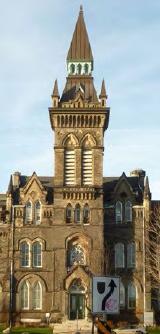Spadina Literary Review — edition 7 page 13
.../
In 2001 a Fine Arts instructor was stabbed to death in a second-floor office. Police never found the murderer. In 2009, a young lady, said to have been on a ghost-hunting expedition, fell to her death off the roof. These two incidents are sufficient to keep the building haunted for as long as ghost tales are told. Another thing is that in 1918 a 21-year-old Amelia Earhart worked here as a nurse’s aide — but it’s hard to conjure a scenario where the tragic aviatrix returns to haunt a workplace she was just passing through.

Tower with eyebrows
But we were talking about architecture. Look at that top-heavy central tower with its dotty multi-layer scholar/wizard hat (with parapet, finials, roof, arcade, pyramidal peak) and also, under the hat's brim, look at those pointed-arch eyebrows making supercilious comment on the building's modern urban context which includes, in mid-foreground, the Scott Mission, where a drifter can get a warm meal, and the CAMH complex where an addict can get emergency treatment, and the Hotel Waverley, which belongs to that category of hotels that is appreciated by guests who like to have the sink real close to the bed.
The real complaint against One Spadina Crescent, however, is that it has never showed much sign of life. The island has up to now been a dead zone.
After the Presbyterians moved out in 1915, the building became a military convalescent hospital. In 1943 Connaught Laboratories moved in and produced vaccines and insulin here. Since 1972, under the U of T's control, the building has seemed only fitfully occupied, a sort of Siberia for misfit departments. The Psychology Department kept an animal lab here, which I guess wouldn’t be all that horrible for the animals — at least the smart rats would win a bite of cheese. Also, the place was used by the Eye Bank of Canada to store eyeballs for transplant.
And (here’s the point I’ve been getting round to) the place was not pedestrian-friendly in the first place, which is a scandalous state of affairs for a university campus.
Knox College very early placed a black iron fence around the circle. Then in 1949 the city widened the roadway by eradicating a boulevard of trees and grass that remained at the circle's circumference, so that from then on the streetcar tracks ran tight to the fence, and pedestrians could not get as much as a toehold on the island. That certainly forestalled people from attempting to cross. Perhaps that was the safest option. Because of the curves, pedestrians do not have a good view of approaching vehicles, and vice versa. The net result, however, was that it was easier to drive to One Spadina Crescent than to walk there. There could be no such thing as a someone casually short-cutting or strolling past Knox’s front door.
Architect Nader Terhani, whom we have mentioned, has various strategies to generate more foot traffic to and on the island. For one thing, there will be no more space for car parking.
Here's a good one: the One Spadina Crescent makeover will include a lookout terrace that will make an occasion out of the view south down Spadina — reprising William Baldwin’s notion, except at street level, and with mid-distance Chinatown and far-distance condo towers instead of Versailles, and with a 3-D perspective of streetcars coming at you. I don’t know about you, but I’ll be hanging out at that spot a lot.
Russell Street, meanwhile, will undergo a mini-renaissance as its east and west stubs are linked by a pedestrian laneway across the island, between the old Knox structure and the new addition. This is one reason Terhani considers his project to be a “bridge between neighborhoods.” The walkway will have some of the functions of a normal street since a student lounge, café and other functions will line it.